Laminate
This material is suitable for finishing the attic floor not only as a floor covering, but also as a wall covering. It has many advantages:
- strength;
- light weight;
- cost;
- wide range.
However, there are also disadvantages: the main disadvantage of laminate is intolerance to temperature changes and high humidity. This makes it impossible to use it in poorly insulated and unheated attics. But if you are placing a playroom, bedroom or living room in the attic, such a finishing will be one of the best options.
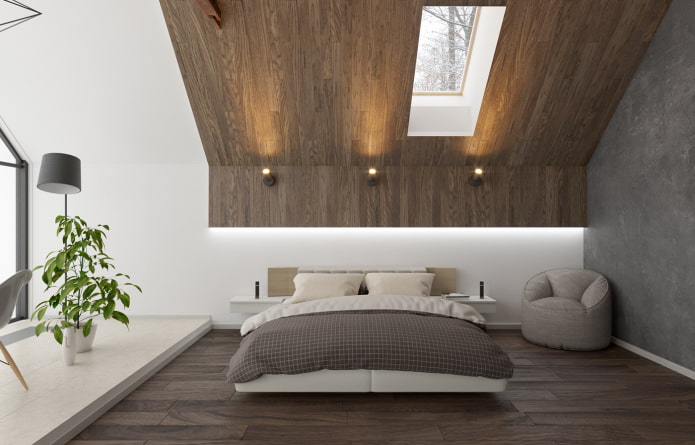
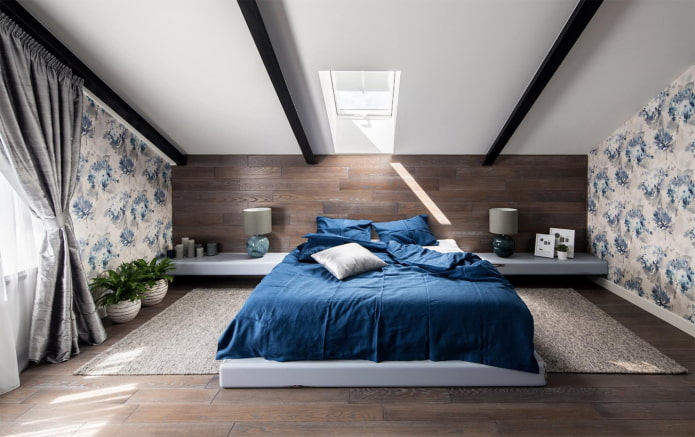
For interior wall paneling, choose laminate of durability class 21-34. The choice of color should be based on the size of the space – the smaller the attic, the lighter the walls should be. Fortunately, you can find laminated boards in white, light gray, light beige shades for any style in stores.
There are 3 ways to lay the panels:
- horizontally (parallel to the floor) – this technique expands the walls;
- vertically (perpendicular to the floor) – raises the ceiling;
- diagonally or herringbone – this idea creates an unusual effect.
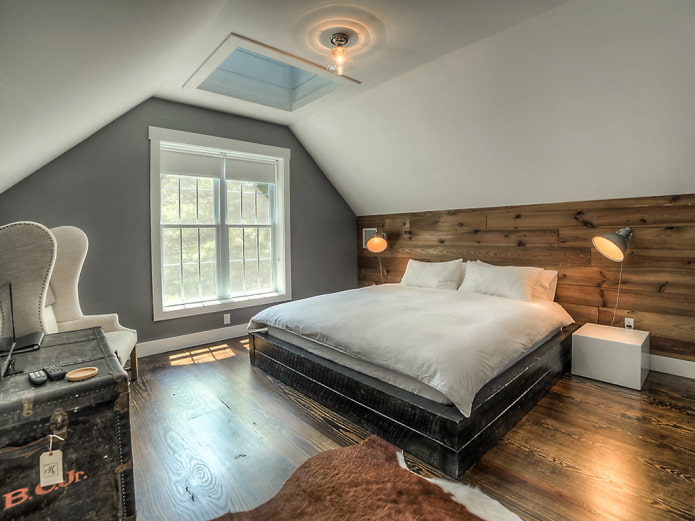
The photo shows an example of finishing the attic with laminate
Plywood
Finishing the attic with plywood is one of the most budgetary and simple options. Advantages of this material:
- strength — your than OSB, MDF and plasterboard;
- durability — retains its original appearance and shape for 10-20 years;
- ease of processing — easy to cut with a regular saw, drill, paint.
But due to the manufacturing features, plywood poses a health hazard in poorly ventilated areas. It releases phenol formaldehyde into the air, which is harmful to the respiratory system, so if you are not sure about the reliability of ventilation, refuse this option for cladding the attic.
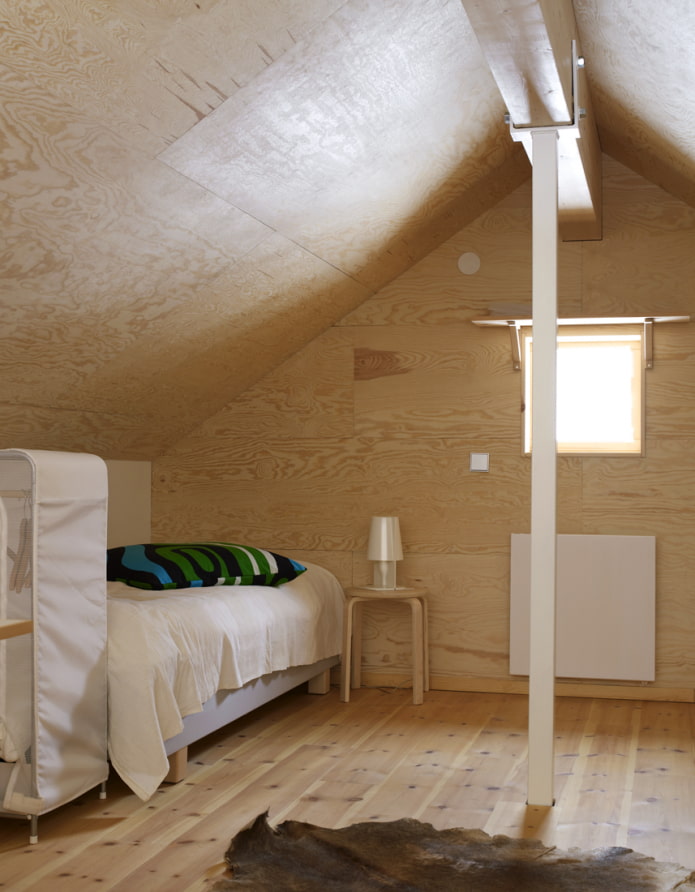

As a finishing material for partitions, walls and ceilings, choose one of 4 options:
- Coniferous sanded plywood, class Ш1, thickness 8-10 mm.
- Sanded birch plywood, class NS / SH1, 8-15 mm.
- Plywood with veneer finish of valuable wood species, 6-10 mm.
- Plywood impregnated with bakelite varnish, 10-15 mm.
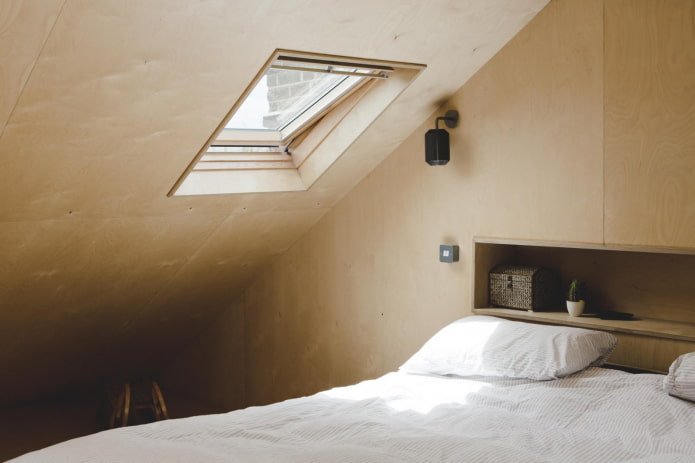
The photo shows warm-colored plywood in the bedroom
Chipboard or MDF
Chipboards are not often used in interior wall decoration. And in vain, because the materials have many advantages:
- strength (high, but less than plywood or natural wood);
- practicality;
- resistance to high temperatures, ultraviolet radiation, fungus, mechanical impacts;
- soundproofing;
- low cost.
Unfortunately, chipboard cannot be called an ideal option for finishing the attic due to its shortcomings: instability to water, moisture, temperature changes.
Two classes of chipboard are used as a finishing material for attic rooms:
- Super E. The safest boards that can be used in all rooms, including children’s rooms.
- E1. The material is considered safe, the formaldehyde content is 10 mg per 100 g of the board weight. It can also be used for children’s rooms in the attic.
The classes below can no longer be used for finishing living spaces.

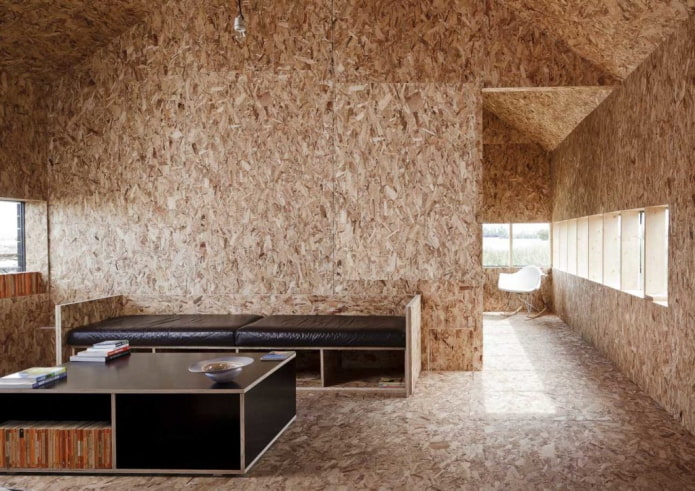
You will find MDF panels on the construction market. They are environmentally friendly, practical and absolutely safe to use – because they do not contain toxic chemicals. The disadvantages of panels are the same as those of chipboard sheets.
Thanks to various options of designer decorative coatings (enamel, veneer, PVC), they are used to cover attics in various designs and styles.

PVC panels
How to finish the attic from the inside to save money and time? With plastic panels! The advantages of using them:
- versatility;
- easy installation;
- moisture resistance;
- resistance to temperature fluctuations;
- wide range;
- easy to maintain.
Of course, they cannot be compared with wood or plywood in terms of strength or sound insulation. But if handled with care, they will last for many years.
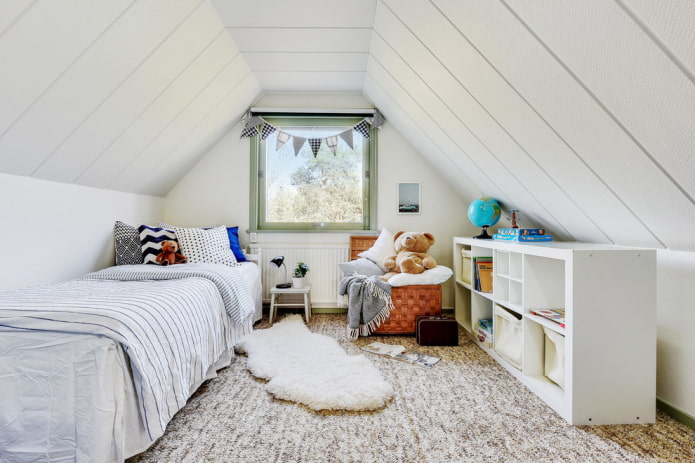
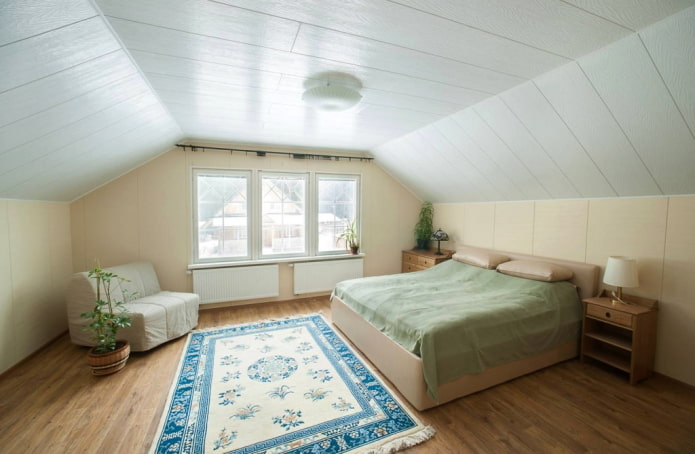
Panels come in different widths:
- Narrow. 10-12 cm. The so-called plastic lining. This is a simple option for replacing painted wooden lining – it will cost less and you won’t have to waste time painting.
- Standard. 25-50 cm. There are two ways to apply a pattern to PVC – offset and thermal printing. The first option is more expensive, but more reliable due to the varnish coating. Thermal printing panels are cheaper and have a wider range, but the pattern may fade or lose brightness over time.
- Wide. 80-200 cm. With the help of sheet panels you will speed up the repair process, because their installation is carried out much faster than any other type.
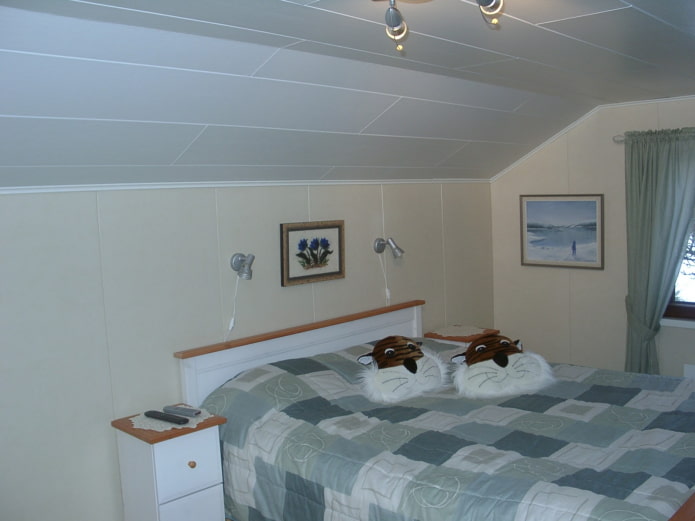
The photo shows a combination of wide and standard panels
Imitation timber
When finishing the attic in a wooden house, you want to emphasize the naturalness of the structure and the interior of the room – in this case, it is preferable to use natural wood.
Imitation timber is a decorative material made of solid wood in the form of a thin panel with chamfers, which help to achieve the desired effect. The thickness of the lamellas varies within 1.2-2 cm, the width is 10-18 cm, the length is 3-6 m.
The interior decoration of the attic floor is done with narrow panels located horizontally, they look more harmonious inside the house.
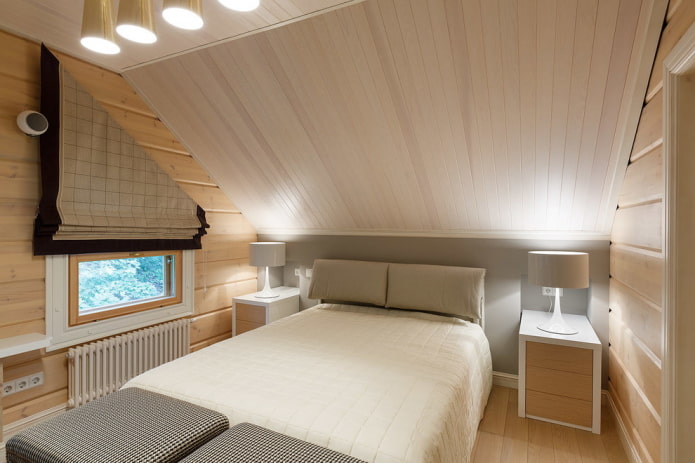
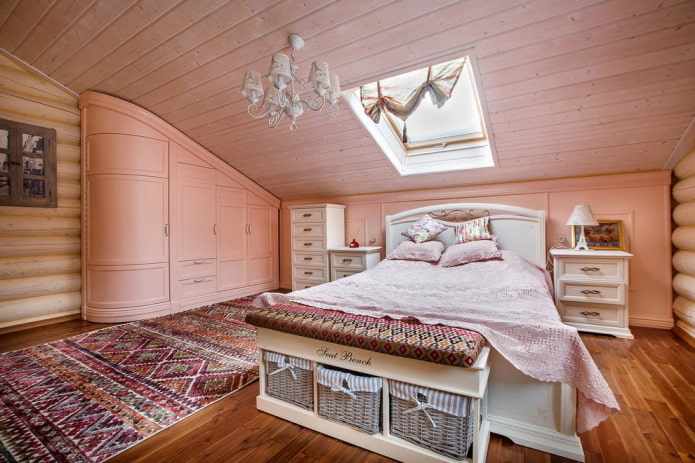
Advantages of imitation timber:
- environmentally friendly;
- easy to install;
- soundproofing;
- durability;
- wide range;
- possibility of changing color.
Don’t forget about the disadvantages of natural wood – to protect against pests, moisture and other adverse effects, treat the boards with a special coating.
Pine is considered the most budget wood, it is perfect for a summer cottage. But if you are going to sheathe the attic or loft in the house where you live permanently, choose more expensive and high-quality species – cedar, larch, oak, alder, maple. Please note that the smell of coniferous trees takes a long time to evaporate, so it is better to give preference to deciduous trees for bedrooms and children’s rooms.
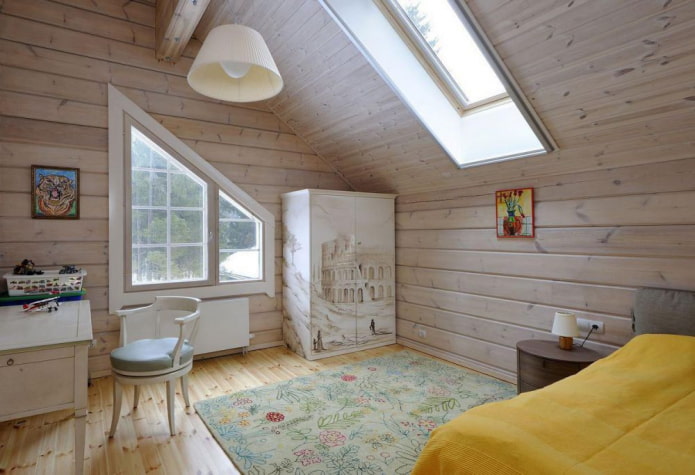
The photo shows a bedroom in the attic with two windows
Wallpaper
The advantages and disadvantages of this material have long been known. When finishing the attic, something else is more important – the choice of direction and size of the pattern. After all, the attic differs from all others not only in its sloping attic ceiling, short walls, but also in lighting – the windows are on the roof, not in the wall.
- Shade. The smaller and darker the attic, the lighter the wallpaper will be. With the help of a light covering you will not only expand the space, but also add light.
- Material. Paper ones are less durable and beautiful, but are more suitable for unheated attics. Vinyl and non-woven ones are for everyone else.
- Pattern. The size of the print also depends on the dimensions of the attic – the smaller it is, the smaller the pattern you can afford.

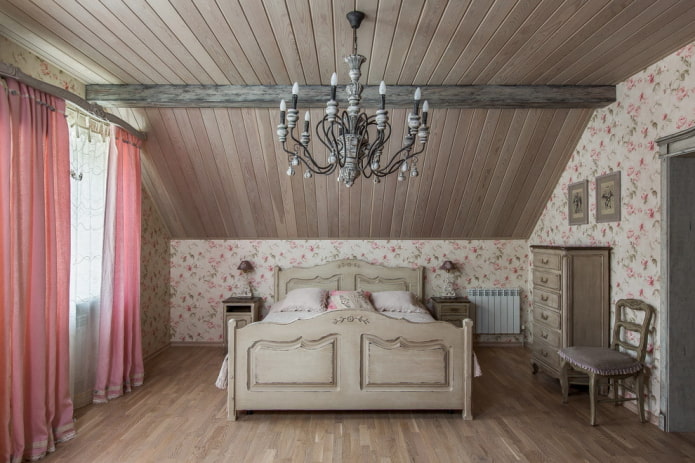
To make the interior look harmonious, the walls of the attic are finished as follows: the sloping walls are plastered and painted with a light, single-color paint, and the straight ones are covered with wallpaper with a print. If the height of the walls allows, combine wallpaper with clapboard: place wooden slats below, and glue wallpaper above them. This attic design option can be done by yourself, it looks very stylish and romantic.
Before pasting, first prepare the walls: finishing the attic with plasterboard will solve the problem of an uneven base, but will take away a few centimeters from the area of the room. Plasterboard sheets are suitable for log houses, in slab or brick structures it is better to level the walls with plaster.

Painting
In modern design, paint is often used for interior decoration of the attic. It is universal, can be tinted in any shade, the walls can be repainted more than once to match a new interior or mood.
However, painting has one big drawback: it requires careful preparation of the walls. It is better to entrust this work to a professional, then the final result will please you for many years.
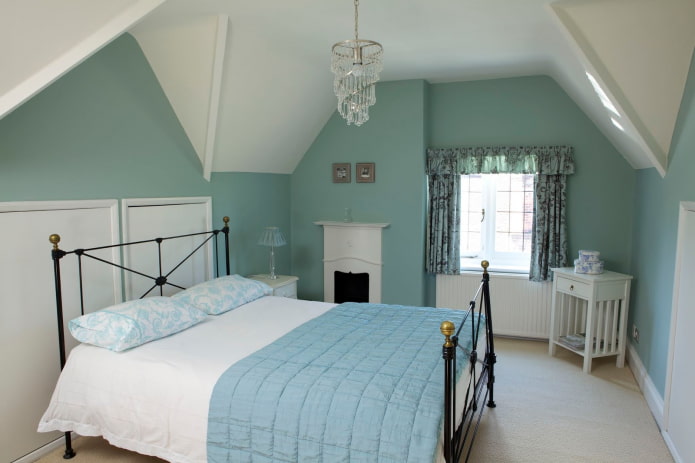

To prevent the space from feeling oppressive, combine several shades: paint the roof and sloping walls white or the lightest shade possible. For the rest, you can choose any palette from light (for small attics) to bright and dark (for large ones).
You can also create interesting effects using a brush and roller. For example, horizontal stripes will visually expand a narrow attic. Vertical ones will make the ceilings higher.

The photo shows a combination of paint shades in the bedroom
Unedged board
An interesting design of the attic with wood can be obtained by using unedged board. This material is obtained by sawing a log lengthwise, but its edges are not processed in any way and remain covered with bark.
For finishing, choose joinery board: higher quality raw materials are used in its production. It is perfect for use inside a private home.
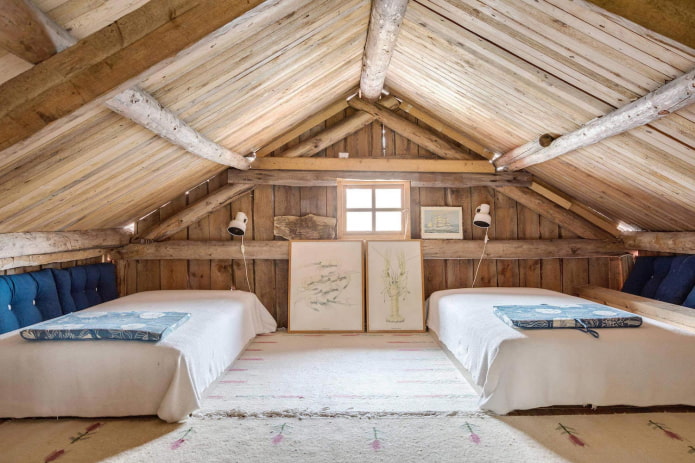
Barn board
One of the most environmentally friendly ways of decoration is the use of secondary raw materials. Barn wood is already used boards that are reused. At the same time, they have a number of advantages compared to fresh wood:
- Absence of pests. Bark beetles and other insects prefer to live on fresh wood, there is nothing useful for them in old wood.
- Stability. The wood has already dried out and changed as much as it could — further deformation is impossible.
- Structure. Marks, bug passages, holes from old nails — all this gives the wood a special charm and is a wonderful decor.
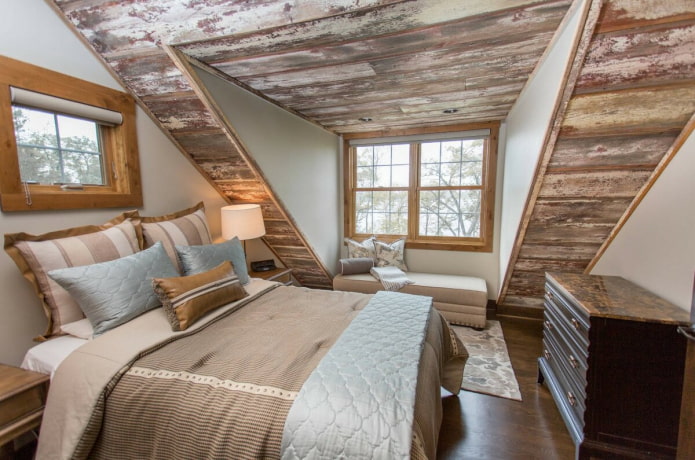
Decorative stone
Finishing the attic with natural materials does not necessarily mean using wood, pay attention to stone. This material is not in vain considered to be the most durable and long-lasting — it will serve on walls for several decades.

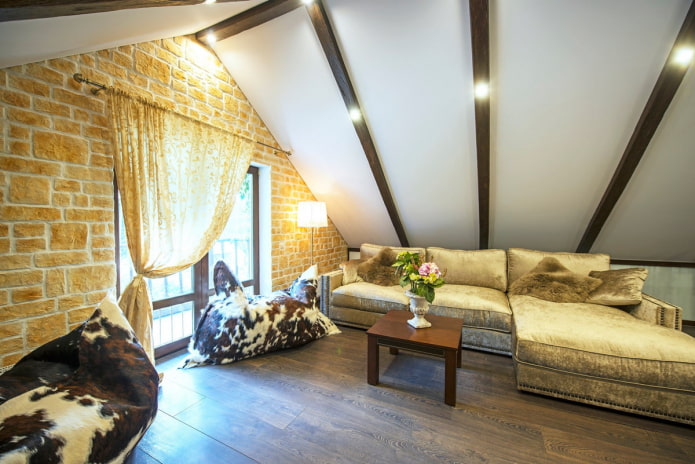
However, stone walls in the bedroom or nursery will look out of place. But in the lounge area or living room, one accent wall made of beautiful stone will look elegant.

Now reading:
- 15 Creative Solutions Instead of a Traditional Headboard
- Color scheme for the hallway and corridor: 55 photos, stylish combinations
- 100 examples of green curtains in the interior: colors, designs and styles of their combination.
- Gray bathroom: 65 photos with design ideas and stylish combinations.
- Effective ways to combat moths in an apartment: reasons for their appearance and 14 solutions.